Choosing your first bass guitar can be overwhelming. Are you tired of sifting through fake Amazon reviews, opinions from inexperienced players, or blatantly biased recommendations? We’ve got you covered with honest, no-nonsense reviews you can trust.
How? We conducted a beginner bass shootout, judged blindfolded by professional bassists. No hype, no favoritism, just reliable reviews you can count on.
 Blindfolded Bass Shootout
Blindfolded Bass Shootout
Too impatient to read everything?
Jump straight to the reviews click here. Or skip to the final verdict and our top picks click here.
How We Conducted Our Bass Guitar Reviews
Selecting the Bass Guitar Contenders
We spent hours online compiling a list of every electric bass guitar we could find under $500. The list grew to around 200 basses – yes, 200!
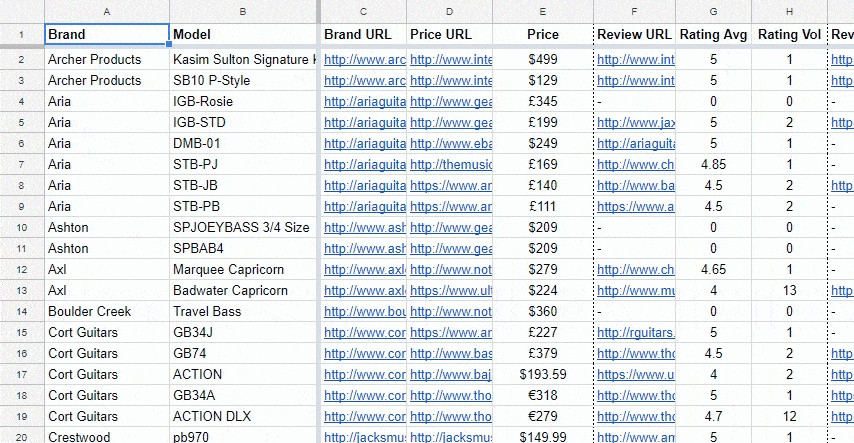 Basses Spreadsheet
Basses Spreadsheet
To narrow down 200 basses to a manageable 7 for our shootout, we used a careful selection process:
1. Reputable Brands Only. We started by filtering out basses from unknown companies and those lacking any online reviews. For beginners, sticking with well-known brands is generally the safest bet.
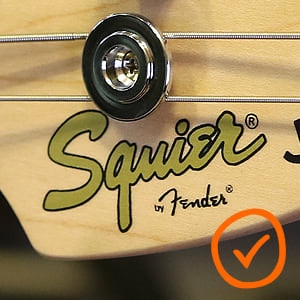 Bass Build Quality Inspection
Bass Build Quality Inspection
2. Four-String Bass Guitars. We focused on four-string models. Learning on a four-string bass is simpler for beginners. You can always explore five or six-string basses later.
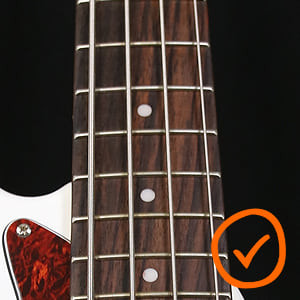 Four String Bass Guitars
Four String Bass Guitars
3. Standard Scale Length. We primarily chose standard 34” scale length basses (with one 35” exception). This is the most common and comfortable scale for most players. If you have smaller hands, short-scale basses might be worth considering (we plan to review these in the future).
 Four String Bass Guitars
Four String Bass Guitars
4. Two Pickups. We limited our selection to basses equipped with two pickups. While single-pickup basses have their place, two-pickup basses are more versatile for beginners. They offer a broader range of tones, allowing you to discover your sound as you explore different music genres.
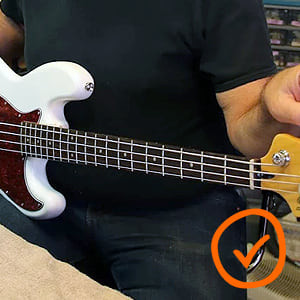 Standard Scale Bass Guitars
Standard Scale Bass Guitars
From there, we further refined our list by considering online reviews, brand popularity, reputation, and our professional judgment to arrive at the final seven basses for our showdown.
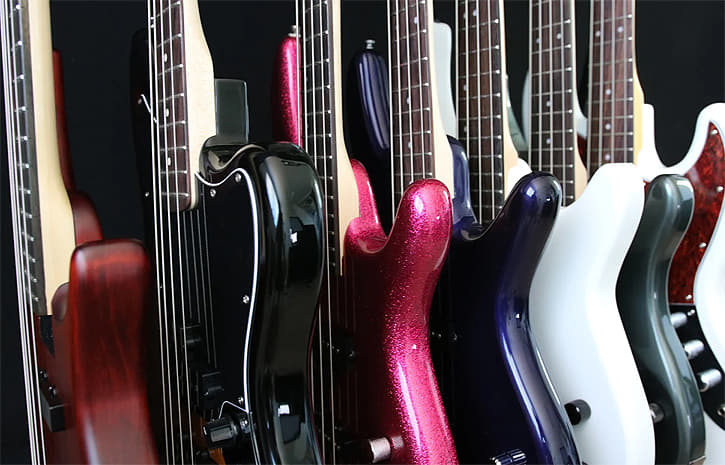 The Contenders Bass Guitars
The Contenders Bass Guitars
Our No-Nonsense Bass Review Process
Our primary goal was to eliminate personal bias as much as possible from these reviews. To achieve this, I blindfolded my two bassist friends so they wouldn’t know which bass they were playing until the end. All three of us have extensive experience across various musical styles, providing a solid foundation for judging tone and feel across different instruments.
 Pro Reviewer Gio Benedetti
Pro Reviewer Gio Benedetti
Pro Reviewer Gio Benedetti
 Pro Reviewer Ben Burleigh
Pro Reviewer Ben Burleigh
Pro Reviewer Ben Burleigh
We approached this review process with genuine curiosity and a desire to offer the best recommendations for beginner basses. We are not sponsored by or affiliated with any of the brands we reviewed, and I encouraged my reviewers to be completely honest in their assessments.
To ensure even greater fairness, we took all seven basses to our trusted bass technician, Kent Fossgreen, a local expert in instrument and amp repair (and also my father). We started by inspecting the build quality and factory setup of each bass.
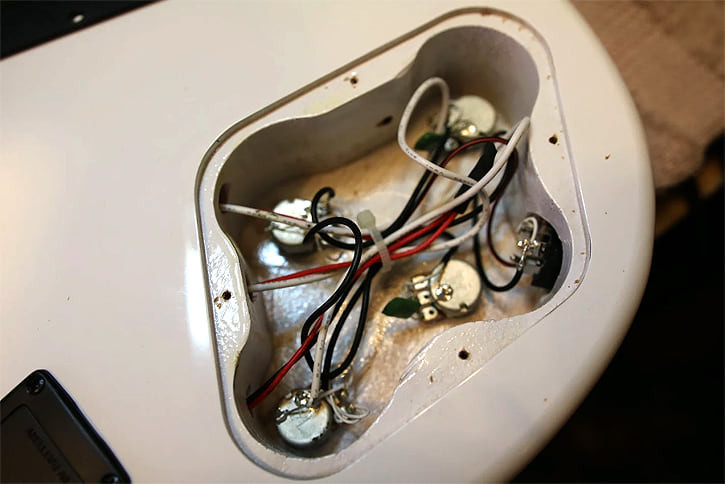 Build Quality Inspection of Bass Guitar
Build Quality Inspection of Bass Guitar
Next, we installed brand new strings on all the basses and performed setups. This ensured that any differences in setup wouldn’t influence our reviewers’ ratings.
In the review room, we monitored the basses through my TC Electronic RH450 amplifier with an RS210 cabinet. We maintained the same flat EQ settings for every bass. Crucially, any tonal or EQ adjustments during the review process were made solely on the basses themselves.
For the audio in the video reviews, I recorded each test bass directly into an Audient iD14 digital audio interface running Logic Pro. To provide the most accurate representation of the “dry” sound of these basses, I used no compression or EQ at any point. Note that this isn’t typical bass recording practice, and all these basses would generally sound even better with standard signal processing.
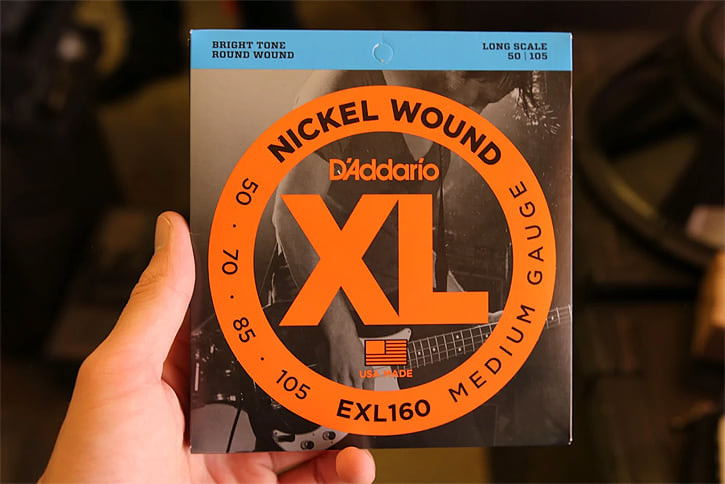 New Strings on Bass Guitars
New Strings on Bass Guitars
Bass Guitar Rating Criteria
Our four review criteria were Playability, Tone, Comfort, and Versatility. Here’s how I explained these terms to the blindfolded reviewers:
1. Playability. This primarily assessed the bass neck – its comfort for movement, string spacing, upper fret access, string tension, and any issues like sharp fret edges or dead spots.
2. Tone. We explored the range of tones achievable using standard fingerstyle technique and adjusting the bass’s knobs. This rating reflected the overall sound quality, the perceived quality of pickups and electronics, and whether we could envision using the bass in a live performance.
3. Comfort. This criterion had the least impact on the overall rating. I asked reviewers about the bass’s weight and balance on their body.
4. Versatility. Reviewers tested various techniques like picking and slapping to evaluate physical comfort and the quality of tones produced by the bass in response to these techniques.
We also had our bass tech examine each bass for build quality. However, since none of the basses had major flaws, this wasn’t directly factored into the rating system. We did include notable tech observations in the “Tech Corner” section for each bass.
The overall rating for each bass is an average of all three reviewers’ scores.
General Technical Observations
All basses arrived in good condition with playable setups. Our bass tech, Kent, noted regarding setup and quality control: “You could confidently buy any of these basses online.” Basses made in Indonesia generally had slightly higher setups than those from China, but all were playable right out of the box.
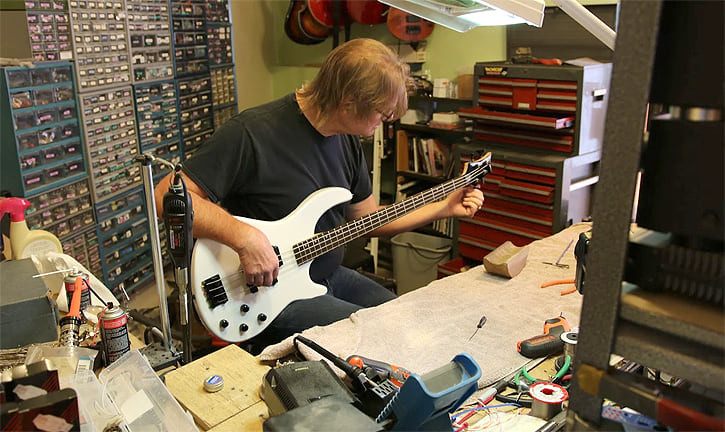 Our Bass Tech Kent
Our Bass Tech Kent
One recurring issue was loose tuner bushings on basses with closed gear tuners. These were likely only hand-tightened at the factory, possibly to prevent damage during shipping. Be aware of this and tighten these bushings with a hex wrench upon receiving your bass to prevent tuner problems.
Epiphone/Tobias Toby Deluxe IV Bass Guitar
Price at Review: $229
| Rating | |
|---|---|
| Playability | 80% |
| Tone | 50% |
| Comfort | 60% |
| Versatility | 60% |
★★☆☆☆
VERDICT: Did this bass live up to the Michael Tobias legacy? In our opinion, not really. Its standout sounds were limited to aggressive rock tones. For other styles, you might want to explore other options for the Best Bass Electric Guitar.
Epiphone/Tobias Toby Deluxe IV Bass Guitar: Detailed Review
You might wonder about the complex name of this bass. Michael Tobias is a renowned bass luthier with decades of experience. After a collaboration with Gibson/Epiphone in the early 90s, he started his own company, MTD (Michael Tobias Design). However, Gibson retained the “Tobias” name.
This Epiphone bass is designed in the style of Michael Tobias, which raised our expectations, having played some of his custom instruments. Let’s see if it lives up to the Tobias name.
Tech Notes
This bass required slightly more setup than others, but it adjusted well. The 9V battery for the active EQ lacked a dedicated compartment and was clipped into the main cavity. However, the battery had detached during shipping, causing rattling inside the bass’s body.
Playability: 8/10
I appreciate the 24-fret neck and easy access to higher frets, though the neck is a bit thicker than my preference. String spacing is wider than I need, but could be beneficial for beginners.
Tone: 5/10
The default tone is thin with excessive top end from the tone knob. Most tones needed the active bass boost to sound good, which isn’t ideal – I prefer a good “plain” sound. However, the bass boost knob was the best among the tested basses, offering a focused sound. My favorite tones were with maxed tone and bass boost, suitable for aggressive rock. I struggled to get a satisfactory funky “quack” due to the bridge pickup’s brittleness.
Comfort: 6/10
The weight and neck balance were acceptable to all reviewers.
Versatility: 6/10
Slapping was uncomfortable due to the bridge’s protrusion digging into my arm. This might not affect all players, but it makes this bass unsuitable for me. Ben and Gio didn’t have this issue and enjoyed the slap tones more.
Specs
| Feature | Specification |
|---|---|
| Manufacturer | Epiphone |
| Series | Toby |
| Model | Toby Deluxe IV |
| Website | Epiphone Official Website |
| Price | $229 |
| Active/Passive | Active (bass boost) |
| Scale Length | 34″ |
| Weight | 7.8lb / 3.54kg |
| Frets | 24 |
| Body Wood | Radiata |
| Neck Wood | Hard Maple |
| Fingerboard Wood | Rosewood |
| Fingerboard Radius | 12″ |
| Pickups | Tobias TBR™ Dual Rail Humbucker x2 |
| Knob Functions | Master Volume, Blend, Tone, Bass Boost |
Snapshots
Epiphone Toby Deluxe IV Bass Guitar Front View
Epiphone Toby Deluxe IV Bass Guitar Body Detail
Epiphone Toby Deluxe IV Bass Guitar Headstock
Squier Vintage Modified Jaguar Bass Guitar
Price at Review: $249
| Rating | |
|---|---|
| Playability | 70% |
| Tone | 60% |
| Comfort | 50% |
| Versatility | 70% |
★★★☆☆
VERDICT: Squier makes solid entry-level instruments, but this Jaguar has some drawbacks. Gio described the active bass boost as a potentially problematic “doom knob” for beginners.
Ratings varied significantly among reviewers. Gio liked it more than Ben and I, possibly due to his familiarity with higher-end Fender Jaguars.
Not the worst beginner bass, but let’s see if we can find a better best bass electric guitar option.
Squier Vintage Modified Jaguar Bass Guitar: Detailed Review
Squier, Fender’s budget line, has long been a staple in the beginner bass market. Having played higher-priced Fender Jaguars, I was curious about the Squier model’s ability to replicate classic Fender tones.
Tech Notes
The Jaguar’s action was slightly high, but intonation was good and factory strings were fresh.
Playability: 7/10
I enjoyed playing it despite its feel not being my typical preference. It has a relatively thick Fender neck and the typical Fender neck block hindering upper fret access, which is a problem for my playing style. Personal preference aside, the neck is comfortable to navigate (except at the top frets). There’s a dead spot on the G string at the 6th fret.
Tone: 6/10
We all agreed the neck pickup was more appealing than the bridge pickup, offering classic Fender Precision-style tones. We found warm vintage soul tones from the neck pickup with the tone rolled down. Again, the bass sounds somewhat thin without the active bass boost, and the bridge pickup lacked desired “quack” and “punch.”
Comfort: 5/10
Fenders/Squiers often feel heavy and bulky to me, with headstocks causing neck dip. This Squier Jaguar was no exception.
Versatility: 7/10
Fingerstyle, slapping, and picking all felt good physically, and produced a few decent tones each.
Specs
| Feature | Specification |
|---|---|
| Manufacturer | Fender |
| Series | Squier Vintage Modified |
| Model | Vintage Modified Jaguar |
| Website | Squier Official Website |
| Price | $249.99 |
| Active/Passive | Active (bass boost) |
| Scale Length | 34″ (864 mm) |
| Weight | 8.8lb |
| Frets | 20 |
| Body Wood | Basswood |
| Neck Wood | Maple |
| Fingerboard Wood | Rosewood |
| Fingerboard Radius | 9.5″ (241 mm) |
| Pickups | Neck: Vintage P-Bass, Bridge: Standard J-Bass |
| Knob Functions | Neck Volume, Bridge Volume, Tone, Bass Boost |
Snapshots
Squier Vintage Modified Jaguar Bass Guitar Body Front
Squier Vintage Modified Jaguar Bass Guitar Body Angle
Squier Vintage Modified Jaguar Bass Guitar Headstock
Squier Vintage Modified Jaguar Bass Guitar Bridge Detail
Cort Action 4 PJ Bass Guitar
Price at Review: $199
| Rating | |
|---|---|
| Playability | 80% |
| Tone | 60% |
| Comfort | 80% |
| Versatility | 70% |
★★★☆☆
VERDICT: Is this lesser-known bass worth considering? Yes, absolutely. We were all pleasantly surprised. While not the best overall, it’s hard to find a better instrument for the price, making it a strong contender for the best bass electric guitar in its budget range. We’re keen to explore Cort’s higher-end offerings in the future.
Cort Action 4 PJ Bass Guitar: Detailed Review
Cort gained our attention through jazz bassist Jeff Berlin’s endorsement in 2014. While focusing on more popular brands for these reviews, we felt Cort deserved a spot.
The Cort Action is also among the least expensive basses in our group. How does this budget-friendly, lesser-known bass compare to the big names?
Tech Notes
Factory setup was excellent out of the box, with no buzz despite a flat truss rod – perhaps the best setup we saw. We did have to max out the E string adjustment at the bridge to dial in the action, indicating less setup flexibility than desired.
Playability: 8/10
I appreciate the 24-fret neck at this price point. However, a deeper cutaway would improve access to the top two frets. As it is, reaching them feels a bit cramped, limiting mobility and chord playing up high. I also wish for a narrower neck at the lower frets. Overall, we’re impressed with the neck and playability.
Tone: 6/10
Perhaps influenced by the sparkly pink finish, I found something appealingly “sweet” or “earnest” in this bass’s tone. It seems to lack some high end – the tone knob isn’t very bright, hindering crystal clarity for harmonics and aggressive rock treble. For general use, I’d keep the tone fully open and roll it off for vintage sounds.
Being passive, tone options are limited, but the available tones are good.
Comfort: 8/10
This bass is light and well-balanced, with no neck dive.
Versatility: 7/10
Fingerstyle and slap feel great. While picking, the neck pickup corners felt slightly sharp when my hand hit them – not dangerously so, just uncomfortable. This could likely be smoothed down.
Specs
| Feature | Specification |
|---|---|
| Manufacturer | Cort |
| Series | Action |
| Model | Action 4 PJ |
| Website | Cort Official Website |
| Price | $199 |
| Active/Passive | Passive |
| Scale Length | 34″ |
| Weight | 8lb |
| Frets | 24 |
| Body Wood | Agathis |
| Neck Wood | Canadian Hard Maple |
| Fingerboard Wood | Rosewood |
| Fingerboard Radius | 15.75″ (400 mm) |
| Pickups | Powersound PSEB4-4/F & PSEB1-4/R |
| Knob Functions | Neck Volume, Bridge Volume, Tone |
Snapshots
Cort Action 4 PJ Bass Guitar Full Body
Cort Action 4 PJ Bass Guitar Body Detail
Cort Action 4 PJ Bass Guitar Neck and Headstock
Cort Action 4 PJ Bass Guitar Angled Body Shot
Ibanez Gio GSR200 Bass Guitar
Price at Review: $199
| Rating | |
|---|---|
| Playability | 60% |
| Tone | 30% |
| Comfort | 60% |
| Versatility | 60% |
★☆☆☆☆
VERDICT: Despite its popularity and positive online reviews, our pro bassist reviewers unanimously disliked this bass. Avoid it.
My only regret in this bass selection is not including a cheaper Ibanez SR model to compare with the Yamaha TRBX304, as they are similarly priced and have much in common. Ibanez SR basses I’ve played are far superior to this GSR200.
Ibanez Gio GSR200 Bass Guitar: Detailed Review
Ibanez is a leading bass guitar manufacturer, and the GSR200 is a popular beginner model. Does it deserve the attention? Let’s find out.
Tech Notes
The Ibanez had a decent setup, no buzz, and acceptable factory strings. Setup was easy. We disliked the flimsy chrome plastic knobs. On the positive side, the headstock features a convenient tool-free truss rod cover.
Playability: 6/10
Playability was average. The neck was playable with decent access to the 22nd fret. The neck felt slightly wider and thicker than I prefer.
Tone: 3/10
This bass had an unpleasant active bass boost knob adding excessive gain and boominess. I couldn’t achieve the funky punch I wanted from the bridge pickup, even when plucking directly over it. The overall tone was dull, even with passive tone maxed.
Comfort: 6/10
Acceptable.
Versatility: 6/10
Plucking, slapping, and picking were physically fine, but tones were consistently lacking.
Specs
| Feature | Specification |
|---|---|
| Manufacturer | Ibanez |
| Series | GSR |
| Model | GSR200 |
| Website | Ibanez Official Website |
| Price | $199.99 |
| Active/Passive | Active (bass boost) |
| Scale Length | 34″ |
| Weight | 7.3lb |
| Frets | 22 |
| Body Wood | Poplar |
| Neck Wood | Maple |
| Fingerboard Wood | Rosewood |
| Fingerboard Radius | 12″ |
| Pickups | Std. P neck, Std. J bridge |
| Knob Functions | Neck Volume, Bridge Volume, Tone, Bass Boost |
Snapshots
Ibanez Gio GSR200 Bass Guitar Full Body
Ibanez Gio GSR200 Bass Guitar Body Detail
Ibanez Gio GSR200 Bass Guitar Headstock Detail
Dean Edge 10 PJ Bass Guitar
Price at Review: $239
| Rating | |
|---|---|
| Playability | 40% |
| Tone | 20% |
| Comfort | 60% |
| Versatility | 40% |
★☆☆☆☆
VERDICT: Despite positive online user reviews, this bass performed poorly in our tests. All three reviewers agreed – only consider this bass for its looks and matching white shoes.
Otherwise, look elsewhere. The discrepancy between user reviews and our experience suggests many bass reviews are written by inexperienced beginners unqualified to judge instrument quality compared to professional instruments. This is definitely not a contender for the best bass electric guitar.
Dean Edge 10 PJ Bass Guitar: Detailed Review
The Dean Edge 10 PJ has very favorable user reviews. Will it pass the test of three professional bass players?
Tech Notes
This bass arrived with no buzz and playable action, but intonation was slightly off on the A and D strings. Pickups had surprisingly high output, causing recording issues. Subtle paint lines were on the finish. Bridge saddles were already maxed out, limiting action lowering.
Playability: 4/10
Despite 22 frets, upper fret access felt restricted by the cutaway. We disliked the overall feel, attributed to setup, string tension, and neck.
Tone: 2/10
Disappointing. Overall boomy and undefined tone. Electronics were confusing and didn’t match manufacturer specs. I couldn’t find a single pleasing sound. The bridge pickup’s unusual position, almost three inches from the bridge (compared to the typical one to two inches), resulted in a lack of expected “quack” and “punch.”
Comfort: 6/10
Slightly heavy. Neck balance was good.
Versatility: 4/10
The fingerboard-to-neck pickup space felt too tight for comfortable slapping, especially index finger pops on lower strings. Finding a comfortable picking spot was also difficult, making it the least pick- and slap-friendly bass tested.
Specs
| Feature | Specification |
|---|---|
| Manufacturer | Dean |
| Series | Edge |
| Model | Edge 10 PJ |
| Website | Dean Official Website |
| Price | $239 |
| Active/Passive | Active (bass boost) |
| Scale Length | 35″ |
| Weight | 8.9lb |
| Frets | 22 |
| Body Wood | Basswood |
| Neck Wood | Maple |
| Fingerboard Wood | Rosewood |
| Fingerboard Radius | 16″ |
| Pickups | DMT Design P, DMT Design J |
| Knob Functions | Neck Volume, Neck Tone, Bridge Volume, Bridge Tone |
Snapshots
Dean Edge 10 PJ Bass Guitar Full Body White
Dean Edge 10 PJ Bass Guitar Body Detail White
Dean Edge 10 PJ Bass Guitar Headstock White
Dean Edge 10 PJ Bass Guitar Bridge Detail White
Yamaha TRBX304 Bass Guitar
Price at Review: $350
| Rating | |
|---|---|
| Playability | 70% |
| Tone | 80% |
| Comfort | 80% |
| Versatility | 90% |
★★★★★
VERDICT: Does paying more get you more? Mostly, yes. The Yamaha TRBX304 has higher quality electronics than any other bass tested. Our tech Kent said: “The Yamaha is a really nice modern bass, with great features for an entry-level model. Fit and finish are excellent, hardware is good… a step above everything else. I’m impressed. You get what you pay for.” A top pick for the best bass electric guitar overall.
Yamaha TRBX304 Bass Guitar: Detailed Review
Does spending more on a beginner bass guitar pay off? We’ll find out by reviewing the Yamaha TRBX304, the most expensive bass in this review series.
Thanks to Loud and Clear Music in Cotati, CA for providing this bass for review. Visit them for a great selection of new and used instruments.
Let’s explore the TRBX304 and see if the higher price is justified.
Tech Notes
Factory setup had slight G-string buzz, easily adjusted. Truss rod needed no tweaking, possibly due to the stable 5-piece neck. Yamaha has higher quality hardware overall compared to other basses.
Playability: 7/10
I felt comfortable on this neck. I like the 24 frets, but a deeper cutaway would improve access. String tension felt slightly “floppy,” possibly fixable by raising the action.
Tone: 8/10
This bass’s higher price is evident in its better electronics, offering more versatility and responsive knobs. Tone issues were more subtle than on cheaper basses.
Overall, tones are modern and somewhat metallic, matching the bass’s look. Even with bass boost and rolled-off treble, I couldn’t quite get a thumpy Motown/soul sound. The neck pickup has a great growl. The bridge pickup is solid with more low end than cheaper bridge pickups, but still lacked desired punch.
While the 5-way EQ selector initially impressed, enthusiasm waned. It felt complex for beginners, and EQ curves weren’t ideal. Slap setting was boomy, solo setting had a nice gain boost but added unwanted low end.
Despite these minor issues, all reviewers rated tone highly. Many usable tones and responsive knobs.
Comfort: 8/10
Solid. Bonus points for thumb rests on pickups.
Versatility: 9/10
Fingers, pick, and slap were all easy and produced good tones. Slapping was particularly enjoyable, with a good modern sound from either the neck pickup alone or both pickups blended.
Specs
| Feature | Specification |
|---|---|
| Manufacturer | Yamaha |
| Series | TRBX |
| Model | TRBX304 |
| Website | Yamaha Official Website |
| Price | $350 |
| Active/Passive | Active |
| Scale Length | 34″ |
| Weight | 9.1lb |
| Frets | 24 |
| Body Wood | Solid Mahogany |
| Neck Wood | Maple and Mahogany 5pc |
| Fingerboard Wood | Rosewood |
| Fingerboard Radius | 10″ |
| Pickups | MHB3n,MHB3b |
| Knob Functions | Master Volume, Blend, Bass/Treble Boost/Cut, 5-way EQ |
Snapshots
Yamaha TRBX304 Bass Guitar Body Front
Yamaha TRBX304 Bass Guitar Body Detail
Yamaha TRBX304 Bass Guitar Headstock Detail
Yamaha TRBX304 Bass Guitar Angled Body
❗ 2024 Update
The Vintage Modified Jazz is discontinued, but Squier’s Classic Vibe series offers a near-identical bass.
Squier Vintage Modified Jazz Bass Guitar
Price at Review: $349
| Rating | |
|---|---|
| Playability | 60% |
| Tone | 70% |
| Comfort | 50% |
| Versatility | 90% |
★★★★☆
VERDICT: Verdict: it rocks. Well-built, simple electronics, delivers classic Jazz bass sounds. Being passive, it has fewer tone options than the Yamaha TRBX304, but its sounds are excellent. A strong contender for the best bass electric guitar in the vintage style.
Bridge pickup ratings varied. My pickup height adjustment likely improved my perception of its tone compared to Ben and Gio’s initial impressions.
Squier Vintage Modified Jazz Bass Guitar: Detailed Review
The Jazz bass is a classic design influencing many basses. Can you get the Jazz bass sound at this price? Let’s test the Squier Vintage Modified Jazz.
Tech Notes
The Jazz bass had good intonation and no buzz. Action was slightly high but playable. Factory strings were lively and consistent.
Playability: 6/10
Fun to play. Shared the Jaguar’s dead spot on the G string’s 6th fret. I liked the neck gloss, but disliked typical Fender issues: large neck block, limited frets, poor upper fret access. Four stars for enjoyment, minus one for Fender issues and dead spot.
Tone: 7/10
Like any passive Fender bass, limited but great tonal options. Neck pickup soloed with tone down provides a “tubular” sound, tone up adds growl and click for hard rock.
Gio and Ben were initially underwhelmed by the bridge pickup, finding it lacking punch and quack (common across these reviews). Adjusting the bridge pickup closer to the strings improved punch and output significantly. It sounded good soloed with tone mostly up, finally achieving the funky punch and quack I sought in these basses.
Comfort: 5/10
Heaviest in the review group, with neck dive due to the bulky Fender headstock. No other comfort issues.
Versatility: 9/10
Pick, fingers, and slap felt and sounded great! Slap sounds were particularly enjoyable from either the solo neck pickup or both combined.
Specs
| Feature | Specification |
|---|---|
| Manufacturer | Fender |
| Series | Squier Vintage Modified |
| Model | Vintage Modified Jazz |
| Website | Squier Official Website |
| Price | $349.99 |
| Active/Passive | Passive |
| Scale Length | 34″ |
| Weight | 9.5lb |
| Frets | 20 |
| Body Wood | Basswood |
| Neck Wood | Maple |
| Fingerboard Wood | Rosewood |
| Fingerboard Radius | 9.5″ |
| Pickups | Fender-Designed Single-Coil Jazz Bass x2 |
| Knob Functions | Neck Volume, Bridge Volume, Tone |
Snapshots
Squier Vintage Modified Jazz Bass Guitar Body Front
Squier Vintage Modified Jazz Bass Guitar Body Detail
Squier Vintage Modified Jazz Bass Guitar Headstock Detail
The Final Bass Guitar Showdown
We’ve reviewed some excellent beginner basses and some surprisingly disappointing ones. Which bass guitar is the best value and wins the BassBuzz Beginner Bass award? Drumroll please…
BASSBUZZ AWARDS BEST BEGINNER BASS GUITAR
Overall Winner: Yamaha TRBX304
The Yamaha TRBX304 unequivocally had the highest construction and electronics quality, offering a wide range of tones for various music styles and playing techniques. The top choice for the best bass electric guitar overall.
Vintage Style Winner: Squier Vintage Modified Jazz
While less versatile than the Yamaha, if you want that classic growly yet refined Fender Jazz sound, the Squier Vintage Modified Jazz delivers a budget-friendly version. A simple, functional Fender-style bass with great core tones. 2024 Update: Squier has replaced the “Vintage Modified” line with the “Classic Vibe” series, offering a nearly identical bass.
Budget Winner: Cort Action 4 PJ
The Cort Action wasn’t the best bass tested, but for its price, it’s well-built and has useful features like a 24-fret neck. If you’re on a tight budget, this bass is a solid beginner instrument.
Key Takeaways for Buying Your Best Bass Electric Guitar
Reviewing, setting up, and having multiple reviewers play these basses was a significant undertaking. What did we learn about choosing the best bass electric guitar for beginners?
1. Beware of Cheap Active Bass Boosts. My reviewers and I are wary of inexpensive active bass boosts. They drastically increase bass output, requiring beginners to be extremely cautious with these knobs, especially in live settings. These basses often sounded thin without the boost, suggesting better results with higher-quality passive pickups and no cheap active electronics. For basses under $300, passive instruments are generally preferable to basses with gimmicky “doom knob” bass boosts.
2. Fret Access Matters. We appreciate classic Fender tones but dislike the bulky neck joint and poor upper fret access. Fender needs to improve this to appeal to players who solo, play chords, tap, or use the upper register extensively.
3. You Get What You Pay For. Our tests largely confirmed that “you get what you pay for.” The pricier Yamaha TRBX304 had superior, more versatile electronics than the other basses.
4. Aim for a $200 Minimum Budget. Based on these basses and past experience, avoid spending less than $200 on a new bass. Cheaper electronics or construction would severely compromise quality. This price range represents the lowest tier of basses I’d consider gigging with. To save money, buy a used bass from a reputable brand, not a new bass from an unknown brand.
5. Personal Feel is Paramount. Both Ben and Gio chose favorites in the shootout that weren’t their highest-rated basses in individual reviews. This highlights that professional bassists prioritize feel. Our detailed analysis is helpful but secondary to personal preference.
Time to Buy Your Bass Guitar
Now you have a good understanding of available beginner basses and what to look for. Hopefully, you’re ready to buy a bass and start playing! What are you waiting for?
P.S. Looking for a good practice amp for your new bass? Check out our amp reviews here.
